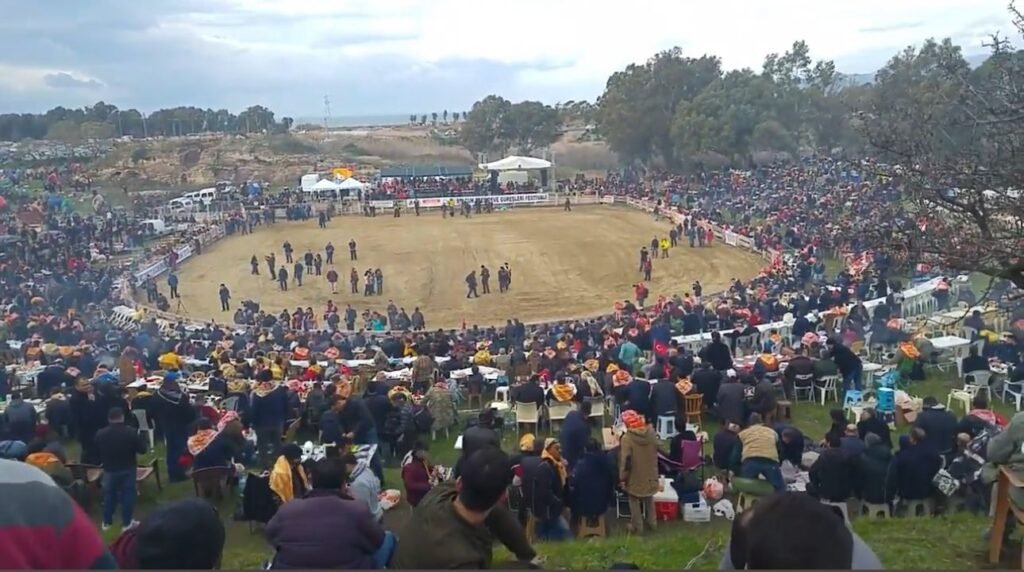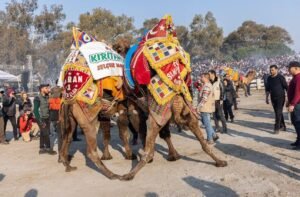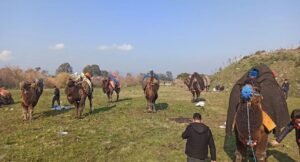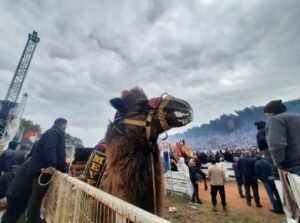Description
**Camel Wrestling – A Roaring Tradition in Selçuk, İzmir, Turkey**
Nestled in the heart of Turkey’s Aegean region, the town of Selçuk in İzmir is famous for more than just the ancient ruins of Ephesus and the House of the Virgin Mary. Each winter, thousands of locals and curious travelers gather in the open fields just outside town for one of the country’s most unique and historic spectacles — *Camel Wrestling* (*Deve Güreşi*). This centuries-old tradition, steeped in culture and color, offers a fascinating window into Turkish rural heritage.
A Tradition Carved in History
Camel wrestling is believed to have originated over 2,000 years ago among the nomadic Turkic tribes of Central Asia. When these tribes migrated westward into Anatolia, they brought their traditions with them — camel wrestling being one of the most eye-catching and community-driven. Though it may sound unusual to outsiders, this practice holds deep cultural and historical roots.
The camels used in wrestling are not wild or aggressive; they are specifically bred and trained for the sport. Known as *Tülü camels*, they are hybrids of two breeds — the fast dromedary and the strong Bactrian camel. Their power, stamina, and impressive stature (some reaching over 1,000 kg) make them the ideal contestants for this type of performance.
When and Where It Happens
The Camel Wrestling Festival in Selçuk is typically held in **January**, making it one of the most anticipated winter events in the region. The town comes alive with excitement as locals prepare for a celebration that includes music, food, and of course, the main event — the matches themselves.
The festival takes place in a dedicated arena known as the *Camel Wrestling Field* (*Deve Güreşi Arenası*), about a 10-minute drive from the town center. The event usually starts in the morning and runs throughout the day, culminating in a final bout between the strongest camels.
The Wrestlers and the Matches
Contrary to what the name might suggest, camel wrestling is not a violent sport. The matches are closely monitored by owners, referees, and event organizers. Two male camels are brought into the ring, both in heat and eager to show off in front of a nearby female camel used to provoke rivalry.
The goal is to pin the opponent to the ground or force them to flee. A win can occur if:
- One camel causes the other to fall
- One camel retreats or refuses to fight
- One camel entangles or restrains the other
The matches usually last no more than 10 minutes and rarely result in serious injury. Once a clear winner is decided, the camels are separated by handlers and celebrated by their owners and fans. Music, zurna (traditional Turkish oboe), and drum performances follow, creating a carnival-like atmosphere.
More Than Just a Match
Camel wrestling in Selçuk is much more than a sporting event; it's a social gathering, a family tradition, and a vibrant showcase of Aegean culture. Weeks before the festival, camels are paraded through villages with decorated saddles, colorful tassels, and embroidered cloths. Their names — often humorous or heroic — are announced proudly. Some popular names include "Kara Şimşek" (Black Lightning), "Yalçın Kayalar" (Steep Rocks), or "Poyraz Fırtınası" (Northwind Storm).
On the day of the festival, spectators arrive early and stake out prime viewing spots. Many bring barbecues, chairs, and coolers, treating the event like a picnic. Families set up campfires, share traditional Aegean dishes, and sip *rakı* (anise-flavored spirit) while cheering on their favorite camel.
Camels as Local Celebrities
Camel owners take immense pride in their animals. Raising a wrestling camel is no easy task — it requires significant investment, patience, and deep knowledge of camel behavior. Owners often travel the regional circuit of camel wrestling tournaments, earning prestige and sometimes cash prizes.
Each camel has its own style. Some are known for their strength, others for agility or clever maneuvers. Fans follow their favorite camels like sports teams, cheering loudly as they enter the arena.
A Controversial Yet Regulated Tradition
Though cherished by many, camel wrestling has faced criticism, particularly from animal rights advocates. Concerns about the welfare of camels during the matches have prompted tighter regulations in recent years. Organizers now work closely with veterinary services to ensure camels are healthy and not subjected to abuse. Fights are supervised, and injuries are treated immediately.
The Turkish government has also classified camel wrestling as an **intangible cultural heritage**, recognizing its role in regional identity and rural tradition. This has helped preserve the practice while encouraging more humane and controlled conditions.
Visiting Selçuk During the Festival
If you're planning to visit Selçuk during camel wrestling season, here are a few tips:
-
Book accommodations early, as the festival draws large crowds.
-
Dress warmly, as January temperatures in İzmir can be chilly, especially in open fields.
-
Bring cash, as many food vendors and stalls don’t accept cards.
-
Rent a car or take a taxi to the arena, as public transportation may be limited during the event.
Beyond the festival, Selçuk is a historical treasure trove. Don’t miss the ancient city of Ephesus, the Temple of Artemis (one of the Seven Wonders of the Ancient World), and the stunning Basilica of St. John. Pairing history with a taste of living tradition like camel wrestling creates an unforgettable travel experience.
Final Thoughts
Camel wrestling in Selçuk is not just a sporting event; it’s a celebration of history, culture, and rural life in Turkey’s Aegean heartland. For those open to discovering the unexpected, it offers a vivid, unfiltered, and entirely unique look into the spirit of Turkish tradition. Whether you're there for the drama of the matches or the joy of the festival, one thing’s for sure — it’s a story you’ll be telling for years to come.
Location
-
Atatürk, 35920 Selçuk/İzmir






